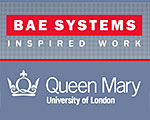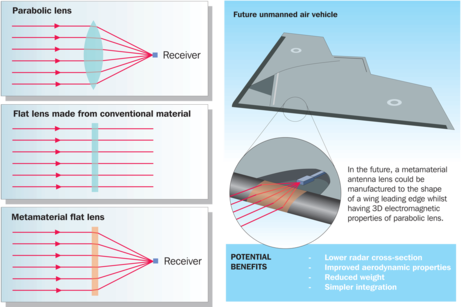Open Innovation Defies Physics to Give Aerodynamics a Lift
Published Oct-12-14Breakthrough:
An open innovation collaboration results in a novel flat antenna lens that could pave the way for more aerodynamic aircraft.
Company:
BAE Systems, United Kingdom
The Story:
 According to news reports, an open innovation collaboration between scientists has resulted in an innovation that has ‘defied the laws of physics’. Researchers from BAE Systems and Queen Mary’s School of Electronic Engineering and Computer Science at the University of London have created a composite material that's been used to manufacture a novel type of flat antenna lens that acts like it's curved. It emulates the electromagnetic properties of a curved lens without any reduction in bandwidth performance.
According to news reports, an open innovation collaboration between scientists has resulted in an innovation that has ‘defied the laws of physics’. Researchers from BAE Systems and Queen Mary’s School of Electronic Engineering and Computer Science at the University of London have created a composite material that's been used to manufacture a novel type of flat antenna lens that acts like it's curved. It emulates the electromagnetic properties of a curved lens without any reduction in bandwidth performance.The breakthrough could lead to revolutionary changes in the design of aircraft, radios, ships, satellite dishes and potentially any other product that uses antennas.
Product of an Open Innovation Partnership
BAE Systems is a British multinational defense, security and aerospace company that adopts open innovation strategies for its R&D. It seeks mutually beneficial relationships across industry sectors, markets and academia.
Together with University of London scientists, it leveraged composite metamaterials and a concept known as transformational optics to do what many would have once deemed impossible.
A metamaterial is an artificial material that exhibits properties that are not found in nature. The material of the new lens has different areas that possess their own electrical properties. It is the special arrangement of these areas that produces a similar effect to the curved geometry of a conventional lens.
Giving Aerodynamics a Lift
Liberating form from function in this way can be useful on planes where antennas can affect the streamlining of a wing. A flat antenna with the 3D electromagnetic properties of a parabolic lens could be built into the craft’s body thereby making it more aerodynamic.
Not only could this lead to changes in aircraft design and weight savings, but there could be benefits in other fields.
Professor Yang Hao from Queen Mary’s School of Electronic Engineering and Computer Science, said: “It’s possible in the future that this research could contribute to the production of even smaller or discrete antennas. This could be useful in all walks of life from telecommunications to healthcare. We’re very pleased that this joint effort between academia and industry has overcome many restrictions on antenna design.”
Dr Sajad Haq from BAE Systems Advanced Technology Centre in Bristol, added: "The project is a great example of academic and industrial collaboration, illustrating perfectly what can be achieved with the right partnerships and skill set."
Next Steps
The open innovation partnership between BAE and Queen Mary’s continues as both sets of scientists are working collaboratively to look for novel applications of their groundbreaking innovation.
Next Story »


